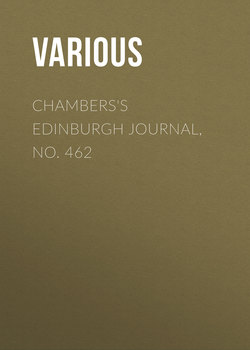Chambers's Edinburgh Journal, No. 462

Реклама. ООО «ЛитРес», ИНН: 7719571260.
Оглавление
Various. Chambers's Edinburgh Journal, No. 462
THE MANAGING PARTNER
THE MOUNTAIN OF THE CHAIN AND ITS LEGEND
IRON SHIPS
SCIENCE OF POLITENESS IN FRANCE
OUR WILD-FRUITS
NICHOLAS POUSSIN
ORIGIN OF MUSIC
THE ARCHARD LEVER POWER
MY SPIRIT'S HOME
THE GUJARATI-HINDOO GIRLS' SCHOOL
Отрывок из книги
The neighbourhood of Gebel Silsilis, or the Mountain of the Chain, is very interesting in many respects. After flowing for some distance through the usual strip of alluvial plain, bordered by not very lofty undulating ground, the Nile suddenly sweeps into a gap between two imposing masses of rock that overhang the stream for above a mile on either hand. The appearance of the precipices thus hemming in and narrowing so puissant a volume of water, covered with eddies and whirlpools, would be picturesque enough in itself; but we have here, in addition, an immense number of caves, grottos, quarries, and rock-temples, dotting the surface of the rock, and suggesting at first sight the idea of a city just half ground down and solidified into a mountain. On the western bank, numerous handsome façades and porticos have indeed been hewn out; and mightily interesting they were to wander through, with their elaborate tablets and cursory inscriptions, their hieroglyphical scrolls, their sculptured gods and symbols, and all the luxury of their architectural ornaments. But the grandest impressions are to be sought for on the other side, whence the materials of whole capital cities must have been removed. There is, in fact, a wilderness of quarries there, approached by deep perpendicular cuts, like streets leading from the river's bank, which must have furnished a wonderful amount of sandstone to those strange old architects who, whilst they sometimes chose to convert a mountain into a temple, generally preferred to build up a temple into a mountain. It takes hours merely to have a glimpse at these mighty excavations, some of which are cavernous, with roofs supported by huge square pillars, but most of which form great squares worked down to an enormous depth.
The rock's on the western bank are not isolated, but seem to be the termination of a range projecting from the interior of the desert; and a minor range, branching off, hugs the river to the northward pretty closely for a great distance; but those on the other side are separated by what may almost be called a plain from the Arabian chain of hills, and might be supposed by the fanciful to have been formerly surrounded by the rapid waters of the Nile. They are admirably placed for the purpose to which they were applied; and although I have not the presumption to fix dates, and say under what dynasty the quarries first began to be worked, there is no rashness in presuming that it must have been at a very early period indeed. The sandstone is excellent for building purposes—far superior to the friable limestone found lower down—and has been removed not only from this one block, but from both sides, here and there, for a considerable distance to the north. Many quarries likewise no doubt remain still undiscovered and unexplored in this neighbourhood. We found the mountains worked more or less down as far as Ramadeh; and inscriptions and sculptures, evidently dating from very ancient times, are met with in many.
.....
[Transcriber's Note: A dieresis (umlaut) diacritical mark appears above the letter 'g' in the word Bergeh in the above sentence in the original.]
Ismaeen sat before me, answering the various questions which the scene suggested. He was a fine open-faced young man, without any of the clownishness of the fellah, and spoke in a free and easy but gentle manner. He told me that he and Abd-el-Mahjid had been sworn friends from infancy; that they scarcely ever separated; that where one went, the other went; and that what one willed, the other willed. They were connected by blood and marriage—the sister of Ismaeen having become the wife of Abd-el-Mahjid. Both had seen what to them was a good deal of the world. They had driven horses, camels, sheep, goats, donkeys, as far as Keneh, even as far as Siout, for sale; and the desert was familiar to them. The salt sea had rolled its blue waves beneath their eyes; and they had been as far as the Gebel-el-Elbi, that mysterious stronghold of the Bisharee, far to the south, in the wildest region of the desert. Ismaeen, it is true, did not seem to think much of these wild and romantic journeyings. He laid more stress on having seen the beautiful city of Siout, where I have no doubt he felt the mingled contempt and admiration ascribed to the Yorkshireman when he first visits London.
.....